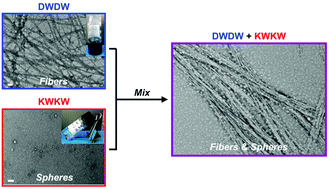Electrostatic-driven self-sorting and nanostructure speciation in self-assembling tetrapeptides†
Abstract
Significant efforts in the field of supramolecular materials have strived to co-assemble small molecules in order to realize individual nanostructures with multiple, tunable activities. The design of self-assembling motifs bearing opposite charges is one commonly used method, with favorable electrostatic interactions used to promote mixing in a resulting co-assembly. This approach, at the same time, contrasts with a typical thermodynamic preference for self-sorting. Moreover, rigorous experimental techniques which can clearly elucidate co-assembly from self-sorting are limited. Here we describe the self-assembly of two oppositely charged tetrapeptides yielding highly disparate nanostructures of fibrillar and spherical assemblies. Upon mixing at different ratios, the disparate nanostructure of the parent peptides remain. Interestingly, while the assemblies appear self-sorted, surface-mediated interactions between spherical and fibrous assemblies translate to increased mechanical properties through enhanced fiber bundling. Moreover, the observed self-sorting is a thermodynamic product and not a result of kinetically trapped pre-existing structures. Taken together, and with the benefit of disparate nanostructures in the parent peptides, we have shown in our system experimental evidence for electrostatic-driven self-sorting in oligopeptide self-assembly.



 Please wait while we load your content...
Please wait while we load your content...